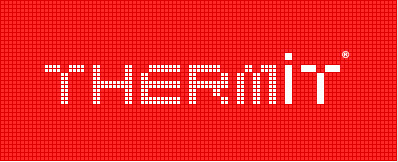THERMIT S sandwich panel covering materials
1. PVC sheet.
PVC sheet 0.8 to 2 mm thick is rigid but light material with a smooth surface. It is easy to process, as it is amenable to drilling, sawing, forming/moulding and milling. PVC is very difficult to ignite. THERMIT S sandwich panel PVC sheet covering is resistant to discolouration, dirt, water and water solutions, and it does not need additional decor.
PVC sheet covering complies with all relevant environmental standards. These sandwich panels can be used in any residential buildings and industrial premises, including processing and food industry premises and even refrigeration industry premises.
THERMIT S sandwich panels with PVC sheet covering are used for facing works of window and door reveals, walls, loggias and balconies, for opaque filling of doors and office partitions and for outdoor advertising manufacturing.
2. Gypsum plasterboard.
Gypsum plasterboard is widely used in interior finishing. It does not contain any toxic substances, and can be used in both residential premises and public places. THERMIT S sandwich panels with gypsum plasterboard covering are used as ready-made partitions and for walls leveling. These sandwich panels do not require any additional soundproofing or heat-insulation. Sandwich panel surface is ready for application of wallpapers, tiles, mosaics or painting.
3. Flat slate (flat asbestos-cement sheet).
Flat asbestos-cement sheet (flat slate) is an artificial stone composite material. Flat slate is durable and resistant to aggressive media and soil. THERMIT S sandwich panels with flat slate covering are easily and quickly installed and can be cut with a simple circular saw or handsaw. One of the great advantages of flat slate is the possibility of paint or any other decoration materials directly on its surface.
Flat slate is a fire-safe material of a nonflammable building materials group. THERMIT S sandwich panels with flat slate covering can therefore be used in hinged ventilated facades systems. THERMIT S sandwich panels with flat slate covering can be used for different constructional utilisations:
- Wall panels for low-rise house building (up to 2 floors);
- Facade facing works of public, residential and industrial buildings (thermal insulation and decorative finishing);
- Roofing;
- Partition walls building;
- Balcony and loggia parapet building.
4. MDF (medium-density fibreboard).
MDF is a type of wood fibreboard. It has a higher density than a particle board and, therefore, in distinction of a particle board, holds screws well. Due to high cross-breaking strength, using THERMIT S sandwich panels with MDF covering is efficient when bent elements (partitions, facades, rounded balconies or loggias) are needed. THERMIT S sandwich panels with MDF covering are also applicable for commercial and industrial premises finishing.
5. OSB (Oriented Strand Board).
Oriented Strand Board is a particle board made by compressing and gluing oriented flat wood chips which has high durability and solidness. OSB Shape stability, structure homogeneity and resistance to mechanical action make it a perfect material for THERMIT S sandwich panels covering.
THERMIT S sandwich panels with OSB covering (OSB type 3 with the highest density) are used in roofing (as a base for bitumen shingles and other coverings), as wall panels in low-rise house building and as a subfloor.
6. CBPB (cement bonded particle board).
Cement bonded particle board is made of cement and wood chips with a small amount of chemical additive for wood chips mineralisation. Cement bonded particle board is not flammable, humidity and low-temperature resistant, fungi, mold and insect-resistant, has good noise-insulation properties, and is an environmentally friendly and hygienically clean building material.
THERMIT S sandwich panels with CBPB covering are used for facade thermal insulation and decorative finishing, as wall panels in low-rise house building or as a roof decking and subfloor.
